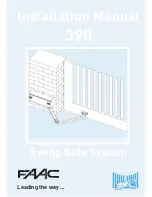
3
Carefully read, follow, and accept all safety precautions and warnings
. I
ncorrect installation can lead
to severe injury or death.
• The gate operator must be installed by a trained gate technician; otherwise serious personal injury or
property damage may occur.
• Installing a gate operator may require installation of standard 110V-120V AC electrical wiring. This
work should only be performed by an experienced electrician. Miswiring could cause personal injury or
DEATH.
• Never let children operate the gate or play around the gate. Keep the remote control away from
children.
• Always keep people and objects away from the gate. Cars, people, and other objects should never
enter when the gate is closing.
• Verify that this operator is proper for the type, weight, and size of the gate.
• Make sure the gate has been properly installed and slides freely in both directions with no resistance.
Repair or replace all worn or damaged gate hardware prior to installation.
• Test gate operator monthly. The gate must reverse when it comes in contact with a solid object, or
stop when an object activates the non-contact sensors. After adjusting the force or travel limit, re-test
the gate operator. Failure to maintain the gate operator properly can increase the risk of injury or
death.
• Use the emergency release only when the gate is not moving.
• Keep the gate and gate operator properly maintained. Read the maintenance section of this manual
and follow the maintenance schedule. Have a certified service technician make repairs or install gate
operator hardware.
• Gate operators can use a huge amount of force to open and close a gate. Therefore, safety features
must be taken into consideration when installing and using a gate operator. Specific safety features
include: photoelectric sensors, edge sensors (contact), moving gate warning signs, guards for exposed
rollers, screen mesh, vertical posts, and more.
• The gate must be installed in a location so that enough clearance is supplied between the gate and
adjacent structures when opening and closing to reduce the risk of entrapment.
• Entrapment is defined as when a person, vehicle, or object is caught or held in a position that
increases the risk of injury.
• Access controls intended for users must be located at least 6 feet (1.8m) away from any moving part
of the gate and where the user is prevented from reaching over, under, around, or through the gate to
operate the controls.
Safety
Содержание CM3
Страница 41: ......





































